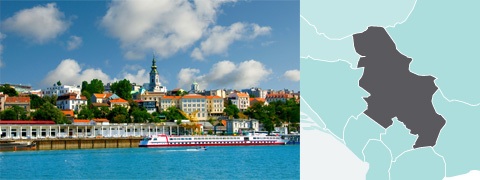Country assessments
Serbia
- Details
- Country assessments
2013 sector transition indicators
Source: EBRD.
Note: Water – Water and wastewater; IAOFS – Insurance and other financial services; PE – Private equity.
Highlights
- Serbia is making progress towards European Union (EU) accession. The Stabilisation and Association Agreement (SAA) entered into force on 1 September 2013, while the first intergovernmental conference on Serbia’s accession negotiations is expected to be held in January 2014.
- Serbia’s fiscal position deteriorated in 2012, but steps have been taken this year to stem the rise in public debt. In October 2013 the government announced a six-point plan to help restore public finances to a more sustainable footing.
- Important reforms in the energy sector have been implemented this year. The introduction of the official model Power Purchase Agreements should help to incentivise investment in renewable energy. Household energy tariffs were increased by 10 per cent in August 2013, but prices still remain at below-cost levels.
Key priorities for 2014
- Sustaining macroeconomic stability, while securing an economic recovery, is the key priority. The government needs to provide a convincing fiscal plan for reducing the level of public debt over the coming years.
- Efforts should be increased to advance the process of restructuring and privatising the remaining state-owned enterprises. Priority privatisations include the telecommunications company, Telekom Srbija, the pharmaceutical company, Galenika, and the steel manufacturer, Zelezara Smederevo. However, restructuring of these enterprises may be needed in order to attract investor interest.
- Reforms are needed to strengthen the stability of the financial sector. Regulatory measures should be taken to incentivise the resolution of non-performing loans (NPLs) and to strengthen deposit insurance.
Macroeconomic performance
The economy entered double dip recession in 2012, with some signs of recovery emerging in the first half of 2013. Last year GDP fell by 1.7 per cent year-on-year, despite a hike in pre-election spending in the first half of the year. The output decline reflected falling domestic private consumption, weak exports and a bad agricultural season. However, data from the first half of 2013 indicate that an export-led recovery has been taking place this year, with GDP rising by 2.7 per cent year-on-year in the first quarter, and by 0.2 per cent year-on-year in the second quarter. Exports are playing a key role in this recovery, having risen by 18 per cent in the first five months of the year compared with the same period in 2012. Inflation has also come down from double-digit levels earlier in 2013, to 4.9 per cent in September 2013, which is within the National Bank of Serbia’s target range of 4 +/- 1.5 per cent.
The currency was under considerable pressure during much of 2012. The central bank intervened a number of times to prevent further depreciation of the dinar against the euro. However, the currency has been stable for several months up to October 2013. Currency movements contributed to the rise in NPLs, which were 19.9 per cent as of mid-2013. Otherwise, the Serbian banking sector has coped well with the crises of the past few years, and the capital adequacy ratio remains strong, at almost 20 per cent.
The fiscal situation is challenging. The end-2012 budget deficit of 6.4 per cent of GDP was well above the target of 4.25 per cent of GDP, and public debt is now around 60 per cent of GDP, which is well in excess of the administrative limit of 45 per cent of GDP. Progress in fiscal adjustment will be needed before any new precautionary loan agreement can be reached with the International Monetary Fund (IMF). The last IMF Stand-By Arrangement was frozen in February 2012 over fiscal slippages, and has subsequently expired. In October 2013 the government announced a six-point plan for budget savings, fiscal stability and economic growth. The plan includes measures to cut government spending, reduce subsidies to state-owned enterprises, lower wages for higher-earning public sector employees and increase the lower rate of value-added tax from 8 to 10 per cent.
A moderate economic recovery is likely in the short term. This is due, in part, to an expected considerable rise in industrial production from the new Fiat factory, and the re-commencement of production at the steel manufacturer, Zelezara Smederevo. However, the combination of weak domestic demand and poor growth prospects for the eurozone will continue to have a major dampening effect on the economy. The necessary fiscal retrenchment expected in the coming year will also weigh heavily on growth prospects. Medium-term prospects remain favourable if economic and structural reforms are undertaken to restore macroeconomic and external stability and improve competitiveness, which are necessary conditions for a restoration of confidence in the domestic and foreign investor communities.
Major structural reform developments
Progress has been made on EU approximation. Two important developments with respect to Serbia’s path towards ultimate EU membership occurred in the past year. First, the SAA with the EU, signed in April 2008, has now been ratified by all member states, and the agreement entered into force in September 2013. Second, in June 2013 the European Council decided that accession negotiations would begin by January 2014.
Negotiations on Word Trade Organization accession are close to being finalised. In June 2013 the Chair of the working party on Serbia’s accession called on Serbia to complete bilateral negotiations and to enact the legislation needed to conclude the process by the end of the year. In addition, Serbia was asked to provide an updated legislative action plan and updated agricultural supporting tables.
Large-scale privatisation remains largely stalled. Very little progress has been made in the past year regarding the sale of certain state-owned assets. Plans for the privatisation of the state-owned telecommunications company, Telekom Srbija, remain unclear, following an unsuccessful attempt to sell a majority stake in the company in 2011. The pharmaceutical company, Galenika, was offered for sale in mid-January 2013, but the tender has been extended several times owing to a lack of investor interest. The government is still searching for a strategic partner for the steel mill, Zelezara Smederevo, which the state bought back from US Steel in early 2012 for a nominal sum of one US dollar. The plant resumed production in April 2013, after an interruption of nine months. However, there has been progress on the restructuring and sale of the national airline, JAT Airways, which has agreed a strategic partnership with the United Arab Emirates’ airline, Etihad Airways. Under the terms of this deal, signed in July 2013, Etihad Airways has acquired 49 per cent of JAT, which is to be renamed Air Serbia.
New power purchase agreements were adopted and electricity prices were increased. In July 2013 the Ministry of Energy adopted the official model Power Purchase Agreements and the Preliminary Power Purchase Agreements, allowing privileged power producers to utilise incentives for green electricity. Further changes to the regulatory environment for renewables are expected by the end of 2013. In the past year the Energy Agency has acquired the authority to determine final tariff levels. In July 2013 the Agency approved a 10.9 per cent rise in household electricity prices, effective from August. Despite this increase, electricity prices remain at below-cost levels, and are still among the lowest in south-eastern Europe.
Certain tax reforms have been introduced, but the business environment remains difficult. In late 2012 the corporate income tax rate was increased from 10 to 15 per cent. Also, certain tax incentives were reduced or eliminated, and the system for introducing non-tax levies was improved and made more transparent. Although these measures are designed to improve the business climate, Serbia’s ranking in the World Bank 2014 Doing Business report was still low, at ninety-third of 189 countries, in terms of overall ease of doing business, with particularly low scores for the sub-components related to dealing with construction permits and paying taxes.
A new law on railways has been introduced. The new law, which entered into force in May 2013, is designed to harmonise the domestic legal framework with EU rules, and to open the sector to competition. The law introduces the principle of separation of railway infrastructure from operations. It remains to be seen whether the new law will lead to more private sector involvement, possibly through a public-private partnership (PPP) scheme. Serbia has had a high-quality PPP and concessions law since November 2011, but, to date, no PPP has been successfully carried out in the transport sector.
Banking sector stability has been maintained, but two smaller state-owned banks have failed. Capital adequacy remains relatively high in the banking sector, at 20.2 per cent in the second quarter of 2013, but credit growth has been weak in the past year (negative in real terms), and NPLs stood at almost 20 per cent of the total by the first quarter of 2013. In the first half of 2013 two smaller state-owned banks failed, at significant cost to the state, which covered all deposits. Credit growth in the private sector has been supported through a government-subsidised lending programme. However, as budgetary funds allocated for corporate loan subsidies expired in the first quarter of 2013, loans to corporates have contracted in the second quarter.
Efforts to promote local currency usage are yielding mixed results in the context of significant economic volatility. The National Bank of Serbia’s “dinarisation” strategy has helped to increase the proportion of lending to households in dinars, from 30.5 per cent in mid-2011 to 36.4 per cent in mid-2013. However, the proportion of local currency in corporate lending has dropped sharply over the same period, from 34.3 per cent in mid-2011 to 22.3 per cent in mid-2013. Household deposits remain overwhelmingly in foreign currency, which likely reflects concerns about macroeconomic stability and uncertainty about future exchange rate movements.













